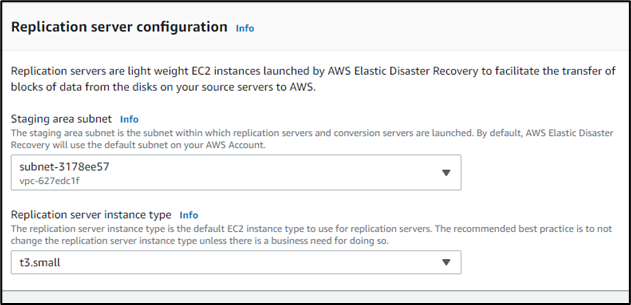|
Voiced by Amazon Polly |
Introduction
Ever since the evolution of information technology, there has always been a requirement for Disaster Recovery methods and techniques.
Various industries like mining, agriculture, education, and Information technology require a disaster recovery system for their purpose. Since the evolution of technology in the cyber world, various cyberattacks, internal security breaches, and natural calamities effect. It is necessary to ensure data integrity, back up the clients’ essential data, and protect our data and businesses from such an unfortunate crisis.
Since the pandemic curve has lowered, there has been a high rise in demand for information technology in business. Therefore, the need for a good disaster recovery strategy is a must to cope with any future unfortunate incidents.
Today we will be talking about configuring a service from Amazon known as AWS Elastic Disaster Recovery – DRS. This precious service helps to failback the AWS server resources and the on-premises server resources with the help of point-in-time recovery (RTO and RPO), minimized compute power, and affordable storage costs provided by the AWS.
Regions Supported
For now, these are the supported regions where you can do back up of your data through elastic disaster recovery:
Freedom Month Sale — Upgrade Your Skills, Save Big!
- Up to 80% OFF AWS Courses
- Up to 30% OFF Microsoft Certs
- Ends August 31
How it Works
With minimal downtime, compute resources, and affordable storage costs, AWS Elastic Disaster Recovery service provides power to recover your Linux or Windows servers, either on-premises or AWS itself.
Architecture Diagram
For cloud disaster recovery, a replication agent is installed on the server to be backed up. All their volumes will be backup up as a point in time snapshot volumes in the region you configured for disaster recovery. A lightweight EC2 instance will be in always running state in AWS VPC, coordinating with the system volumes and replicating the data. Point in time snapshot volumes will be available based on the settings configured according to the mentioned retention period. You can recover the servers by a failback recovery approach which will use the volumes to create an EC2 instance of your choice of computing power. However, the storage used will always be equal or greater than the one in the server to be backed up.
With a new EC2 instance now launched up, you can use the EC2 to get your application up and to run or perform recovery back to the on-premises server with the help of a replication agent, which was installed initially.
Let’s follow the steps for AWS Elastic Disaster Recovery
- Choose your On-premises or AWS EC2 machine, which has to be backed up
Here we are using a ubuntu 18.04 machine for the demo
 The communication between source servers and Elastic DRS takes place over port 443 and TCP port 1500; make sure you have these ports open in the security group
The communication between source servers and Elastic DRS takes place over port 443 and TCP port 1500; make sure you have these ports open in the security group

- SSH into the machine install the replication agent given by AWS elastic disaster recoveryWe will also make a demo text file which will be recovered at the end of the task

- For Installing replication agent on the source serverRun the following command below and replace the region within which you want the replication to happenYou will also be required to be the root user for the process
 Install the downloaded agent
Install the downloaded agent For different operating systems, follow these steps: https://docs.aws.amazon.com/drs/latest/userguide/adding-servers.html/
For different operating systems, follow these steps: https://docs.aws.amazon.com/drs/latest/userguide/adding-servers.html/

- AWS Elastic disaster recovery agent console
You would need to set up the configuration for replication servers for further replication from the AWS DRS service
Here you can select storage type, security group, data routing, etc. properties for your lightweight replication server

- With all the correct replication server settings and replication agents installed in the source servers, you will find the progress of the replication status

- You will now find the source server in Ready state for Recovery

Also, you will find a lightweight instance of your choice as a replication server that will communicate with the source servers at all given times in your EC2 section

Your replication server will be attached to 2 or more volumes at a given time. One will be the root storage, and all others will be a point in time captured volumes of your source servers

- Recovery
You can now perform a recovery or a drill to recover your source server in case of a disaster
Choose the point in time you want to recover your source server You will see a conversion server that converts your data in captured volumes for use in an EC2 instance, this will be there in your AWS region for a few minutes and will terminate automatically as soon as its job is done
You will see a conversion server that converts your data in captured volumes for use in an EC2 instance, this will be there in your AWS region for a few minutes and will terminate automatically as soon as its job is done

After some time, you can see your backed up server launched in the AWS region, VPC, subnet you chose in the launch template associated with the AWS DRS service which can be modified at any given point in time

You can finally SSH into the new machine and find your files backed up

Summary
The need for a disaster recovery plan for servers you are using is more important than ever but at the same time also affordable with AWS Elastic disaster recovery service. In addition, one can back up his data to other far regions, which will come in handy during the data center crisis. AWS DRS is quick, reliable, and affordable with minimal latency synchronization because of state-of-the-art storage devices and computing power. Not only do services like these help in disaster but also for moving data from one region to another or for any internal loss of data for both on-premises and AWS-backed servers.
Freedom Month Sale — Discounts That Set You Free!
- Up to 80% OFF AWS Courses
- Up to 30% OFF Microsoft Certs
- Ends August 31
About CloudThat
CloudThat is an award-winning company and the first in India to offer cloud training and consulting services worldwide. As a Microsoft Solutions Partner, AWS Advanced Tier Training Partner, and Google Cloud Platform Partner, CloudThat has empowered over 850,000 professionals through 600+ cloud certifications winning global recognition for its training excellence including 20 MCT Trainers in Microsoft’s Global Top 100 and an impressive 12 awards in the last 8 years. CloudThat specializes in Cloud Migration, Data Platforms, DevOps, IoT, and cutting-edge technologies like Gen AI & AI/ML. It has delivered over 500 consulting projects for 250+ organizations in 30+ countries as it continues to empower professionals and enterprises to thrive in the digital-first world.

WRITTEN BY Akshay Mishra
Akshay Mishra works as a Subject Matter Expert at CloudThat. He is a Cloud Infrastructure & DevOps Expert and AWS Certified. Akshay is experienced in designing, securing, and managing scalable cloud infrastructure on AWS. Proven track record working with government, pharmaceutical, and financial clients in roles such as Cloud Engineer, Associate Solutions Architect, and DevOps Engineer. He is skilled in AWS infrastructure, CI/CD, Terraform, and cloud security, with certification in AWS Security – Specialty.


 Login
Login


 March 20, 2022
March 20, 2022

 PREV
PREV











Comments